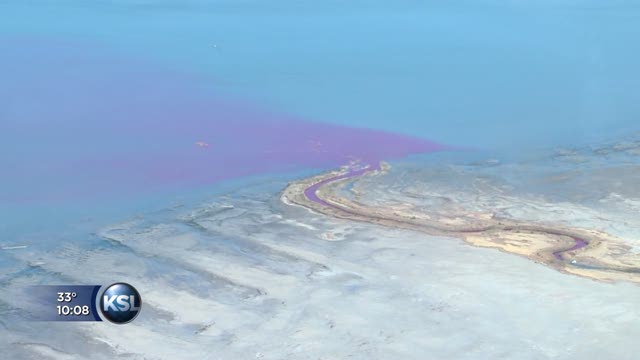Estimated read time: 3-4 minutes
This archived news story is available only for your personal, non-commercial use. Information in the story may be outdated or superseded by additional information. Reading or replaying the story in its archived form does not constitute a republication of the story.
SALT LAKE CITY — There was a striking sight on the Great Salt Lake, at least for people who might have flown over it Wednesday.
A sizable portion of the lake turned bright red.
The color came from a small stream that enters the lake near Saltair, a color change that was planned by scientists as part of a large-scale experiment. They're trying to get a better understanding of how pollutants contaminate the lake. The striking color gives them a way to visualize it.
The dye mimics pollutants, particularly selenium, which can be a threat to waterfowl.
"Weather conditions are perfect for this," said Patrick Lambert, a hydrologist for the U.S. Geological Survey.

As he spoke, red dye spurted into the waters of Lee Creek about 12 ounces at a time. Every few seconds, an automated pump sent a burp of fluorescent red dye into the stream, which is at its lowest flows of the year.
"It's much easier to work at lower flow," said USGS hydrologist Briant Kimball. "The same amount of dye will be more visible in the lake."
As the dye drifted out of the creek and into the lake, it gave scientists a way of seeing how the freshwater mixes with water significantly saltier than the world's oceans.
"One of the questions that we need to answer better is, how do these discharges diffuse into the Great Salt Lake?" said John Whitehead of the Utah Division of Water Quality. "What sort of mixing are we getting? And that's very important to us to make sure we protect the Great Salt Lake and the beneficial uses of the Great Salt Lake."
The dye study is aimed at obtaining information on the dispersion, direction of movement, and travel times of potential contaminants entering the south shore area of Great Salt Lake. -USGS
A few hundred yards offshore, scientists in a boat collected water samples. They also operated an unmanned mini-submarine that gathered data below the surface.
Scientists want to know what happens as pollutants move out of streams into the lake. "Is it dispersed so that it is no longer a concern or is it concentrated in certain areas?" Kimball said. The answers to those questions could help scientists and planners figure out how to regulate facilities that discharge pollutants into the lake's tributaries.
"There are questions about timing," Lambert said. "When should discharges take place? At what locations in the lake should they take place, to minimize the effect of those discharges to the lake?"
The scientists say the tracking dye is harmless and breaks down quickly in sunlight. As the red plume drifted into the lake Wednesday morning, Lambert said, "The coloration in the lake will be gone by tomorrow."
The data from the experiment will be analyzed over the next year or so and then made available to planners. It can be used to create scientific models of the water movements.
In the future, similar experiments will likely be conducted at other locations on the lake. It's part of a big push by federal and state scientists in recent years to get better handle on the unique behavior of the Great Salt Lake.
Email:hollenhorst@ksl.com







